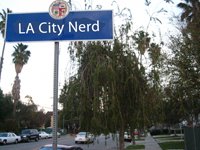 This week, Councilman Tom LaBonge (largely known as L.A.'s cheerleader), joined locals to celebrate Larchmont Boulevard's 85th Anniversary. Often looked to as the desire of shopping districts from Brentwood to Toluca Lake, Larchmont's tree-lined, angle-parked street is a design that is often lauded as what our shopping districts should be.
This week, Councilman Tom LaBonge (largely known as L.A.'s cheerleader), joined locals to celebrate Larchmont Boulevard's 85th Anniversary. Often looked to as the desire of shopping districts from Brentwood to Toluca Lake, Larchmont's tree-lined, angle-parked street is a design that is often lauded as what our shopping districts should be.This section has been subject to many improvements from an off-street parking structure developed as a public private partnership over 15 years ago to new stop signs for pedestrian safety. Q-conditions were adopted in November of 1992 by the City in this area as a planning tool to refine the uses allowed and restrict the number of restaurants and financial institutions. The property-owners even formed a BID in the mid-1990s to self-assess themselves to continue the improvement of the area.
It's appropriate that Tom LaBonge, who for over 20 years has aided the Boulevard (first as a field deputy for then-Councilman John Ferraro), oversaw the festivities this week. He helped initiate height limits in the mid-80s, worked to develop the public/private partnership parking structure, and recently, as Councilman, brought traffic control and beautification in the form of stop signs & medians to the Boulevard. The Councilman has a connection to Larchmont, too, in that his name is only one letter different than Larchmont's founder, Labonte!
The short section of city street, called "the city's quaintest boulevard" in 1999 by Los Angeles Magazine, was first paved in 1920. In 1993, the L.A. Times scantly recounts the founding of Larchmont 85 years ago:
"The emergence of Larchmont Boulevard as one of the city's few real neighborhood walking streets is a historical accident. Its original developer, Julius Labonte, laid it out in 1921 as part of one of the suburban subdivisions that slowly crept west from downtown during the 1920s and '30s. The Los Angeles Railway's Yellow Cars line ran up the middle of the street, and along the sides there were stores and some second-story offices. As the neighborhood grew more prosperous, so did the merchants. The streetcars and telephone poles were removed in the 1950s, making the street quieter, visually as well as in terms of decibels."
Here's a little photo from an old Times article from 1920 lauding the new area:

Was it really an accident that created this urban oasis?


No comments:
Post a Comment